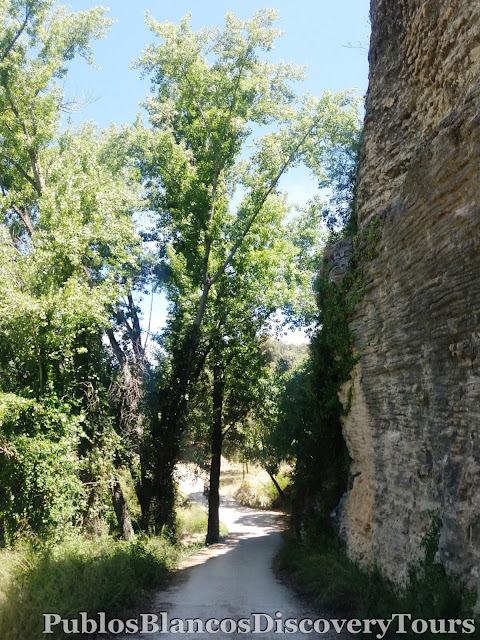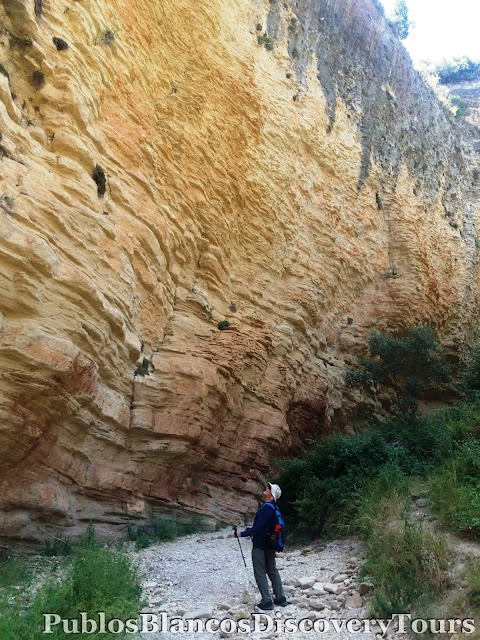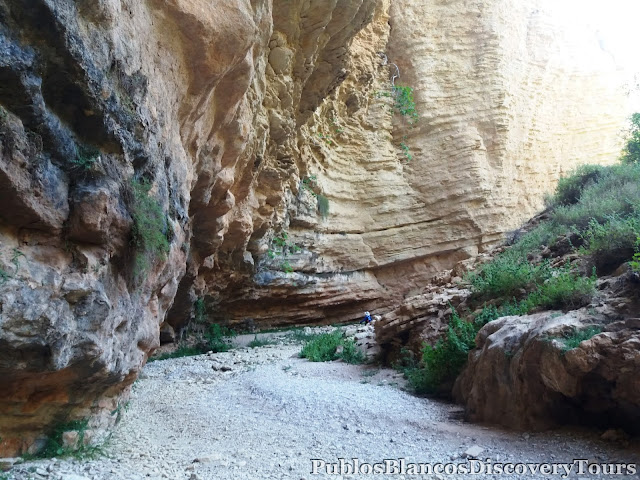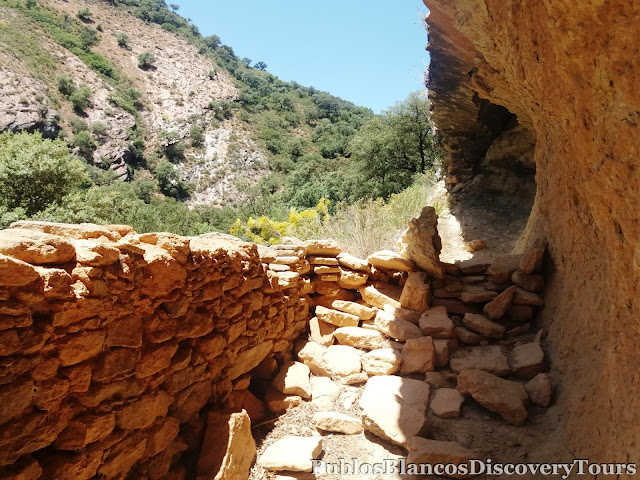A Walk through the gorge of
"Tajo de Abanico"
Prologue:
The gorge of Tajo de Abaníco near Ronda is a well hidden geological treasure. The meaning of Tajo (the gash) is a deep and vertical cut formed in the ground by the erosion of a river or by another accident in the ground.
The Sijuela stream has cut through the rock in millennia and exposed the various layers of rock strata (Sedimentary rock and Conglomerate), beautiful coloured layers of sandstone, formed by rain and wind. The word Abaníco (fan) gives this gorge the rightful name because of its fan like appearance.
The gorge was used part of a film set and immortalized by the big screen, in the filming of the opera "Carmen" by Bizet, (the main part being played by the magnificent Spanish tenor, Plácido Domingo).
The walk to the gorge was very pleasant, olive groves, cork and holm oak, blooming Broom bushes and many wildflowers at the way side. Stunning views along the way and amazing rock structures. What an incredible landscape, we very much enjoyed this fascinating place.
Directions:
- Coming from Marbella A-7 you exit in San Pedro de Alcántara and take the A-397 north towards Ronda.
- After approx. 47 km you exit A-397 and at the next roundabout you take the 3rd exit. You drive south in direction Algecíras A-369.
- It takes about 3,2 km to the Mirador del Pino from the roundabouts. Its certainly worth a stop at this viewpoint to take in the panoramic views of the town of Ronda.
- From the viewpoint head north/west and after 700 m take a left turn towards the Barrio of San Francisco - Calle Pila Doña Gaspara.
- After 350 m turn sharp left at the junction and stay on Calle Pila Doña Gaspara.
- Keep left and drive for approx. 2,5 km until you find a wide space at a crossroad where you can leave your car.
- From here take the left road which later turns into a footpath and leads you towards the gorge of Tajo de Abaníco.
 |
| Click on link: Wikiloc: Tajo de Abaníco, Ronda |
The Hike approx. 2,9 km to the end of the gorge, was fairly easy. The last 3rd part we walked in the riverbed, which in the wet season you might not be able to do.
Note: Good shoes are advisable and not to forget some drinks to take along.
The viewpoint is named after this magnificent Stone pine.

The Yellow Broom bushes which line the main road are in full bloom
from April until July.
After we parked the car at the crossroad, we followed the arrow towards the left.
On the route we pass Olive groves (Olivares) and Holm oak (Encina) and
Gall oaks (Quejigo) can be seen.
A view west along an olive grove.
On the horizon the mountains of the Sierra de Grazalema nature reserve.
Ahead of us an old ruin.
The arrow pointing us in the right direction.
On the way we pass various farms.
Ahead of us on the left side, some high cliffs.
We pass through a gate which points us towards "Tajo de Abaníco".
Don't forget to close the gate behind you.
Elm trees (Olmo), which can reach a height of 30 m, can be seen here.
In the protection of the cliff a Holm oak stands tall.
A view west, overlooking a farm.
The yellow flowers of the Broom bushes brighten up the countryside.
Birds of prey as well as swallows, pigeons and others use these rock-faces.
The layers of rock strata, formed by natural forces look like a
gigantic abstract work of art.
A view south/west across a forest of Holm oaks.
The further we walk the more rugged the terrain seems to become.
What a vista!!
Ahead of us "Tajo de Abaníca"
So rugged and untamed!
The Gorge, called after the fan like appearance of rock formations.
Holding back the huge wall of Conglomerate!
Amazing to see where and how trees are able to grow.
Suddenly we step onto a cobbled footpath.
This cobbled path, some believe it is Roman, but more likely it is of medieval origin.
This clearing was the highest point of our walk.
We wonder if this plaza was used for special events.
Incredible panoramic views.
Deep down somewhere the stream "Sijuela".
The footpath winds its way on.
Poppies on the wayside, a nice contrast!
We carry on and follow the track downwards.
Natures layered cake!
Markings on the rock indicate that we are on the right path.
We find ourselves now at the bottom of the gorge and in the riverbed.
We feel ourselves dwarfed!
It is hard to imagine how much water will be gushing around the corner
in the rainy season.
Incredible how the force of water can carve through the rock ,in time.
Some rock climbing enthusiasts chose to climb up this rock.
Ahead of us a large cave.
You are able to find many caves in this area.
We carry on along the river bed.
Astonishing to see where plants are able to root and flower.
As the gorge opened up again, and we find ourselves surrounded by lush vegetation.
This is as far as we went, the fence stopped us venturing on more.
South end of the gorge and a view towards the Sierra de las Nieves.
Holm oaks are widely found throughout the gorge.
As we looked towards the high cliff wall we noticed a man made wall.
An ideal shelter for a Shepard or wanderers who got caught out by bad weather.
Some scattered bones, we wonder what animal it was.

To see if we can contribute to keep the wall intact.
This stone will do!
As we turned a corner, this magnificent rock stood out like a huge thumb
In the depth of the riverbed.
We leave the riverbed behind us and
we find ourselves back on the footpath, walking upwards.
A view towards the hidden stream of Sijuela.
Another view across the gorge, it was certainly a fantastic experience.
On our way back we walked through the olive grove.
There stood some ancient olive trees.
Their is still life in this old tree yet !
Just the right spot for our picnic.
We sit here admits the mature olives.
A view across the olive grove.
Map of the hike
 |
| Click on link: Wikiloc: Tajo de Abaníco, Ronda |
How to get to Ronda and Tajo de Abanico.












































































































No comments:
Post a Comment